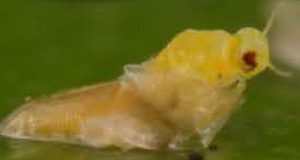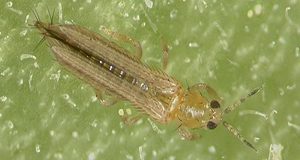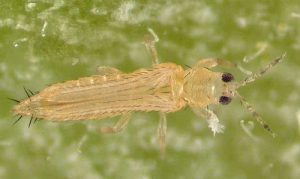Considered an emerging pest in Florida, the solanum whitefly has been in the state since at least the 1960s. It eats pepper, eggplant, and tomato, as well as other food crops, ornamental plants, and weeds. Learn to identify the little pest with this handy, 2-page guide written by Nicole A. Casuso and Hugh A. Smith and published by the UF/IFAS Entomology and Nematology Department.
http://edis.ifas.ufl.edu/in1201
Tag: Hugh A. Smith
Pest Identification Guide: Rugose Spiraling Whitefly, Aleurodicus rugioperculatus
Rugose spiraling whitefly (Aleurodicus rugioperculatus) feeds on over 118 hosts including coconut palm, gumbo limbo, and other fruits and ornamentals. It is a major pest in Florida. Learn to identify these tiny flies with this handy, 2-page guide written by Nicole A. Casuso and Hugh A. Smith and published by the UF/IFAS Entomology and Nematology Department.
http://edis.ifas.ufl.edu/in1202
Pest Identification Guide: Ficus Whitefly Singhiella simplex
Ficuswhitefly (Singhiella simplex) is found on ficus species, especially weeping fig. It is a major pest in Florida. Learn to identify these tiny flies with this handy, 2-page guide written by Nicole A. Casuso and Hugh A. Smith and published by the UF/IFAS Entomology and Nematology Department.
http://edis.ifas.ufl.edu/in1203
Pest Identification Guides, August 2016
Created to help growers and crop consultants, private homeowners, Master Gardeners, and the general public identify common arthropod pests and the damage they inflict, each field guide provides photos of the important life stages and crop damage associated with arthropod pests. The text highlights key general morphology and biology, distribution, and natural enemies. Written by Jeffrey Cluever and Hugh Smith, and published by the UF Department of Entomology and Nematology.
The following have been added to the existing series, http://edis.ifas.ufl.edu/topic_series_pest_identification_guides
Pest Identification Guide: Western Flower Thrips Frankliniella occidentalis (Pergande)
Western flower thrips transmits the carmovirus Pelargonium flower break virus (PFBV), the ilarvirus Tobacco streak virus (TSV), and the tospoviruses Chrysanthemum stem necrosis virus (CSNV), Groundnut ringspot virus (GRSV), Impatiens necrotic spot virus (INSV), Tomato chlorotic spot virus (TCSV), and Tomato spotted wilt virus (TSWV). This species is primarily a flower feeder, so most damage would be expected on the flower or fruit. Learn to identify the western flower thrips with this two-page illustrated guide written by Jeffrey D. Cluever and Hugh A. Smith and published by the Department of Entomology and Nematology.
http://edis.ifas.ufl.edu/in1127
Pest Identification Guide: Melon Thrips Thrips palmi Karny
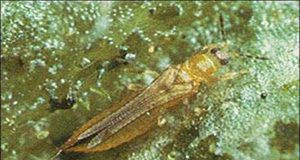
Melon thrips transmits Calla lily chlorotic spot virus (CCSV), Groundnut bud necrosis virus (GBNV), Melon yellow spot virus (MYSV), Tomato spotted wilt virus (TSWV), and Watermelon silver mottle virus (WSMoV). This species is primarily a foliage feeder (except in pepper and eggplant, where flowers are more preferred). Feeding on the leaves results in yellowing followed by death of leaf. Leaf feeding can also cause terminal growth to be discolored, stunted, and malformed. Feeding on fruit may cause scarring and malformed fruit. Learn to identify the melon thrips with this two-page illustrated guide written by Jeffrey D. Cluever and Hugh A. Smith and published by the Department of Entomology and Nematology.
edis.ifas.ufl.edu/IN1126
Pest identification Guide: Florida flower thrips Frankliniella bispinosa (Morgan)
The Florida flower thrips is a known pest of blueberry but its status in other crops is unclear. Florida flower thrips transmits Tomato spotted wilt virus and possibly other tospoviruses. This species is primarily a flower feeder, so most damage would be expected on the flower or fruit. Learn to identify the Florida flower thrips with this two-page illustrated guide written by Jeffrey D. Cluever and Hugh A. Smith and published by the Department of Entomology and Nematology.
edis.ifas.ufl.edu/in1125
Pest Identification Guide: Chilli thrips Scirtothrips dorsalis Hood
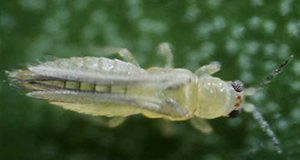
Chilli thrips transmits the ilarvirus Tobacco streak virus (TSV) and the tospoviruses Groundnut bud necrosis virus (GBNV), Groundnut chlorotic fan-spot virus (GCSFV), and Groundnut yellow spot virus (GYSV). This species primarily feeds on young, tender foliage. Feeding on foliage may result in silvering leading to necrosis, leaf curl (upward), distortion, and defoliation. Feeding on the fruit may cause scarring, discoloration, and the formation of corky texture on the fruit. Learn to identify the chilli thrips with this two-page illustrated guide written by Jeffrey D. Cluever and Hugh A. Smith and published by the Department of Entomology and Nematology.
http://edis.ifas.ufl.edu/in1124


